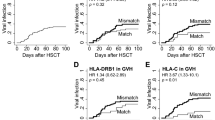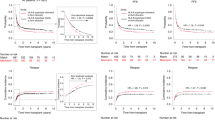Abstract
Viral infection is one of the lethal adverse events after cord blood transplantation (CBT). Human leukocyte antigen (HLA) and killer immunoglobulin-like receptor (KIR) ligand divergences can increase the risk of viral infection due to conflicting interactions between virus-infected cells and immune cells. However, the relationship between these disparities and the frequency of viral infection after CBT remains to be evaluated. Herein, we have conducted a retrospective multicenter study to assess the effect of HLA and KIR ligand mismatches on viral infections after CBT. The study included 429 patients, among which 126 viral infections occurred before day 100. Viral infection was significantly associated with poorer overall survival (OS; hazard ratio [HR] 1.74, p < 0.01). Patients harboring ≥3 mismatches in the HLA allele and inhibitory KIR ligand mismatches (HLA & KIR mismatches) had a significantly greater prevalence of viral infection (HR 1.66, p = 0.04). Thus, patients with HLA & KIR mismatches had poorer outcomes in terms of non-relapse mortality (HR 1.61, p = 0.05). Our study demonstrates the unfavorable impacts of HLA & KIR mismatches on viral infections and non-relapse mortality after CBT. Evaluating the viral infection risk and performance of an appropriate and early intervention in high-risk patients and optimizing the graft selection algorithm could improve the outcome of CBTs.
This is a preview of subscription content, access via your institution
Access options
Subscribe to this journal
Receive 12 print issues and online access
$259.00 per year
only $21.58 per issue
Buy this article
- Purchase on Springer Link
- Instant access to full article PDF
Prices may be subject to local taxes which are calculated during checkout





Similar content being viewed by others
Data availability statement
Raw data were created by KSCTG. Data supporting the study findings can be available from the corresponding author (YA) upon request.
References
Niederwieser D, Baldomero H, Szer J, Gratwohl M, Aljurf M, Atsuta Y, et al. Hematopoietic stem cell transplantation activity worldwide in 2012 and a SWOT analysis of the Worldwide Network for Blood and Marrow Transplantation Group including the global survey. Bone Marrow Transpl. 2016;51:778–85.
Yamamoto H. Single cord blood transplantation in Japan; expanding the possibilities of CBT. Int J Hematol. 2019;110:39–49.
Ogata M, Oshima K, Ikebe T, Takano K, Kanamori H, Kondo T, et al. Clinical characteristics and outcome of human herpesvirus-6 encephalitis after allogeneic hematopoietic stem cell transplantation. Bone Marrow Transpl. 2017;52:1563–70.
Scheurer ME, Pritchett JC, Amirian ES, Zemke NR, Lusso P, Ljungman P. HHV-6 encephalitis in umbilical cord blood transplantation: a systematic review and meta-analysis. Bone Marrow Transpl. 2013;48:574–80.
Hill JA, Koo S, Guzman Suarez BB, Ho VT, Cutler C, Koreth J, et al. Cord-blood hematopoietic stem cell transplant confers an increased risk for human herpesvirus-6-associated acute limbic encephalitis: a cohort analysis. Biol Blood Marrow Transpl. 2012;18:1638–48.
Beck JC, Wagner JE, DeFor TE, Brunstein CG, Schleiss MR, Young J, et al. Impact of cytomegalovirus (CMV) reactivation after umbilical cord blood transplantation. Biol Blood Marrow Transpl. 2010;16:215–22.
Montesinos P, Sanz J, Cantero S, Lorenzo I, Martín G, Saavedra S, et al. Incidence, risk factors, and outcome of cytomegalovirus infection and disease in patients receiving prophylaxis with oral valganciclovir or intravenous ganciclovir after umbilical cord blood transplantation. Biol Blood Marrow Transpl. 2009;15:730–40.
Matsumura T, Narimatsu H, Kami M, Yuji K, Kusumi E, Hori A, et al. Cytomegalovirus infections following umbilical cord blood transplantation using reduced intensity conditioning regimens for adult patients. Biol Blood Marrow Transpl. 2007;13:577–83.
Walker CM, van Burik JH, De For TE, Weisdorf DJ. Cytomegalovirus infection after allogeneic transplantation: comparison of cord blood with peripheral blood and marrow graft sources. Biol Blood Marrow Transpl. 2007;13:1106–15.
Lunde LE, Dasaraju S, Cao Q, Cohn CS, Reding M, Bejanyan N, et al. Hemorrhagic cystitis after allogeneic hematopoietic cell transplantation: risk factors, graft source and survival. Bone Marrow Transpl. 2015;50:1432–7.
Gilis L, Morisset S, Billaud G, Ducastelle-Leprêtre S, Labussière-Wallet H, Nicolini FE, et al. High burden of BK virus-associated hemorrhagic cystitis in patients undergoing allogeneic hematopoietic stem cell transplantation. Bone Marrow Transpl. 2014;49:664–70.
Tomonari A, Takahashi S, Ooi J, Fukuno K, Takasugi K, Tsukada N, et al. Hemorrhagic cystitis in adults after unrelated cord blood transplantation: a single-institution experience in Japan. Int J Hematol. 2006;84:268–71.
El-Zimaity M, Saliba R, Chan K, Shahjahan M, Carrasco A, Khorshid O, et al. Hemorrhagic cystitis after allogeneic hematopoietic stem cell transplantation: donor type matters. Blood. 2004;103:4674–80.
Robin M, Marque-Juillet S, Scieux C, Peffault de Latour R, Ferry C, Rocha V, et al. Disseminated adenovirus infections after allogeneic hematopoietic stem cell transplantation: incidence, risk factors and outcome. Haematologica. 2007;92:1254–7.
Vandenbosch K, Ovetchkine P, Champagne MA, Haddad E, Alexandrov L, Duval M. Varicella-zoster virus disease is more frequent after cord blood than after bone marrow transplantation. Biol Blood Marrow Transpl. 2008;14:867–71.
Townsend A, Bodmer H. Antigen recognition by class I-restricted T lymphocytes. Annu Rev Immunol. 1989;7:601–24.
Iemura T, Arai Y, Kanda J, Kitawaki T, Hishizawa M, Kondo T, et al. Impact of HLA class I allele-level mismatch on viral infection within 100 days after cord blood transplantation. Sci Rep. 2020;10:21150.
Danby R, Rocha V. Improving engraftment and immune reconstitution in umbilical cord blood transplantation. Front Immunol. 2014;5:68.
Schaffer M, Malmberg KJ, Ringden O, Ljunggren HG, Remberger M. Increased infection-related mortality in KIR-ligand-mismatched unrelated allogeneic hematopoietic stem-cell transplantation. Transplantation. 2004;78:1081–5.
Zhao XY, Luo XY, Yu XX, Zhao XS, Han TT, Chang YJ, et al. Recipient-donor KIR ligand matching prevents CMV reactivation post-haploidentical T cell-replete transplantation. Br J Haematol. 2017;177:766–81.
Leung W. Use of NK cell activity in cure by transplant. Br J Haematol. 2011;155:14–29.
Ruggeri L, Capanni M, Urbani E, Perruccio K, Shlomchik WD, Tosti A, et al. Effectiveness of donor natural killer cell alloreactivity in mismatched hematopoietic transplants. Science. 2002;295:2097–100.
Ogata M, Takano K, Moriuchi Y, Kondo T, Ueki T, Nakano N, et al. Effects of prophylactic foscarnet on human herpesvirus-6 reactivation and encephalitis in cord blood transplant recipients: a prospective multicenter trial with an Historical Control Group. Biol Blood Marrow Transpl. 2018;24:1264–73.
Okamoto S, Kondo S, Yano K. Guideline for hematopoietic cell transplantation - Infection control in early-phase after transplantation. The Japanese Society for Hematopoietic Cell Transplantation Guideline. 2012;1:5–25.
Atsuta Y. Introduction of Transplant Registry Unified Management Program 2 (TRUMP2): scripts for TRUMP data analyses, part I (variables other than HLA-related data). Int J Hematol. 2016;103:3–10.
Fine JP, Gray RJ. A proportional hazards model for the subdistribution of a competing risk. J Am Stat Assoc. 1999;94:496–509.
Kanda Y. Investigation of the freely available easy-to-use software ‘EZR’ for medical statistics. Bone Marrow Transpl. 2013;48:452–8.
Sigal LJ, Crotty S, Andino R, Rock KL. Cytotoxic T-cell immunity to virus-infected non-haematopoietic cells requires presentation of exogenous antigen. Nature. 1999;398:77–80.
Itano AA, Jenkins MK. Antigen presentation to naive CD4 T cells in the lymph node. Nat Immunol. 2003;4:733–9.
Jenkins MK, Khoruts A, Ingulli E, Mueller DL, McSorley SJ, Reinhardt RL, et al. In vivo activation of antigen-specific CD4 T cells. Annu Rev Immunol. 2001;19:23–45.
Brodin P, Hoglund P. Beyond licensing and disarming: a quantitative view on NK-cell education. Eur J Immunol. 2008;38:2934–7.
Marcenaro E, Cantoni C, Pesce S, Prato C, Pende D, Agaugue S, et al. Uptake of CCR7 and acquisition of migratory properties by human KIR+ NK cells interacting with monocyte-derived DC or EBV cell lines: regulation by KIR/HLA-class I interaction. Blood. 2009;114:4108–16.
Welsh RM, Brubaker JO, Vargas-Cortes M, O’Donnell CL. Natural killer (NK) cell response to virus infections in mice with severe combined immunodeficiency. The stimulation of NK cells and the NK cell-dependent control of virus infections occur independently of T and B cell function. J Exp Med. 1991;173:1053–63.
Armstrong AE, Smyth E, Helenowski IB, Tse WT, Duerst RE, Schneiderman J, et al. The impact of high-resolution HLA-A, HLA-B, HLA-C, and HLA-DRB1 on transplant-related outcomes in single-unit umbilical cord blood transplantation in pediatric patients. J Pediatr Hematol Oncol. 2017;39:26–32.
Eapen M, Klein JP, Ruggeri A, Spellman S, Lee SJ, Anasetti C, et al. Impact of allele-level HLA matching on outcomes after myeloablative single unit umbilical cord blood transplantation for hematologic malignancy. Blood. 2014;123:133–40.
Eapen M, Wang T, Veys PA, Boelens JJ, St Martin A, Spellman S, et al. Allele-level HLA matching for umbilical cord blood transplantation for non-malignant diseases in children: a retrospective analysis. Lancet Haematol. 2017;4:e325–33.
Yokoyama H, Morishima Y, Fuji S, Uchida N, Takahashi S, Onizuka M, et al. Impact of HLA Allele Mismatch at HLA-A, -B, -C, and -DRB1 in Single Cord Blood Transplantation. Biol Blood Marrow Transpl. 2020;26:519–28.
Brunstein CG, Wagner JE, Weisdorf DJ, Cooley S, Noreen H, Barker JN, et al. Negative effect of KIR alloreactivity in recipients of umbilical cord blood transplant depends on transplantation conditioning intensity. Blood. 2009;113:5628–34.
Rocha V, Ruggeri A, Spellman S, Wang T, Sobecks R, Locatelli F, et al. Killer cell immunoglobulin-like receptor-ligand matching and outcomes after unrelated cord blood transplantation in acute myeloid leukemia. Biol Blood Marrow Transpl. 2016;22:1284–9.
Tanaka J, Morishima Y, Takahashi Y, Yabe T, Oba K, Takahashi S, et al. Effects of KIR ligand incompatibility on clinical outcomes of umbilical cord blood transplantation without ATG for acute leukemia in complete remission. Blood Cancer J. 2013;3:e164.
Willemze R, Rodrigues CA, Labopin M, Sanz G, Michel G, Socie G, et al. KIR-ligand incompatibility in the graft-versus-host direction improves outcomes after umbilical cord blood transplantation for acute leukemia. Leukemia. 2009;23:492–500.
Sanz J, Jaramillo FJ, Planelles D, Montesinos P, Lorenzo I, Moscardo F, et al. Impact on outcomes of human leukocyte antigen matching by allele-level typing in adults with acute myeloid leukemia undergoing umbilical cord blood transplantation. Biol Blood Marrow Transpl. 2014;20:106–10.
Yokoyama H, Kanda J, Kawahara Y, Uchida N, Tanaka M, Takahashi S, et al. Reduced leukemia relapse through cytomegalovirus reactivation in killer cell immunoglobulin-like receptor-ligand-mismatched cord blood transplantation. Bone Marrow Transpl. 2021;56:1352–63.
Yokoyama H, Takenaka K, Nishida T, Seo S, Shinohara A, Uchida N, et al. Favorable effect of cytomegalovirus reactivation on outcomes in cord blood transplant and its differences among disease risk or type. Biol Blood Marrow Transpl. 2020;26:1363–70.
Acknowledgements
The authors would like to thank all the physicians and data managers at the participant centers who provided valuable transplantation data. We thank the KSCTG, including the Kyoto University Hospital, Kobe City Medical Center General Hospital, Japanese Red Cross Osaka Hospital, Kurashiki Central Hospital, Tenri Hospital, Kokura Memorial Hospital, Shizuoka General Hospital, Takatsuki Red Cross Hospital, Japanese Red Cross Wakayama Medical Center, Shinko Hospital, Kyoto City Hospital, Kitano Hospital, Japan Red Cross Otsu Hospital, Kyoto-Katsura Hospital, and Shizuoka Cancer Center. This study was supported in part by research funding from the Pfizer Competitive Grant Program, Japanese Society for Hematology, Japan Health Academy, Foundation for Promotion of Cancer Research, Lotte Foundation in Japan, and the Program for the Development of Next-generation Leading Scientists with Global Insight (L-INSIGHT), sponsored by the Ministry of Education, Culture, Sports, Science and Technology (MEXT), Japan to YA.
Author information
Authors and Affiliations
Consortia
Contributions
TI and YA designed the study, reviewed and analyzed data, and wrote the paper; T Kitawaki, T Kondo, JK, YK, and AT-K interpreted data and revised the manuscript; YU, TM, KI, AY, KY, NA, SK, MN, T Kitano, MI, NA, TM, MW, and MT contributed to data collection and provided critiques on the manuscript.
Corresponding author
Ethics declarations
Competing interests
The authors declare no competing interests.
Additional information
Publisher’s note Springer Nature remains neutral with regard to jurisdictional claims in published maps and institutional affiliations.
Supplementary information
Rights and permissions
About this article
Cite this article
Iemura, T., Arai, Y., Kitawaki, T. et al. Coexistence of HLA and KIR ligand mismatches as a risk factor for viral infection early after cord blood transplantation. Bone Marrow Transplant 57, 781–789 (2022). https://doi.org/10.1038/s41409-022-01621-w
Received:
Revised:
Accepted:
Published:
Issue Date:
DOI: https://doi.org/10.1038/s41409-022-01621-w
This article is cited by
-
Aciclovir
Reactions Weekly (2023)



